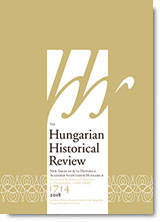The Participation of the Medieval Transylvanian Counties in Tax Collection
The Participation of the Medieval Transylvanian Counties in Tax Collection
Author(s): András W. KovácsSubject(s): 13th to 14th Centuries
Published by: Magyar Tudományos Akadémia Bölcsészettudományi Kutatóközpont Történettudományi Intézet
Keywords: Middle Ages; Transylvania; tax collection; counties; pecunia udvarnicalis; taxa; contributio; subsidium
Summary/Abstract: In Transylvania the county authorities had to assist in collecting royal (state) taxes owed by the serfs of noble estates (like in other parts of Hungary). In 1324 the king exempted the Transylvanians from paying the tax called collecta that they previously had to submit to the voivode. (Based on analogies, it can be suggested that this tax was collected either because of the cancellation of the yearly renewal of money or the refusal of the compulsory exchange of older money.) From 1336 the yearly renewal of money and with this the compulsory exchange of the former money ceased to exist. In order to compensate this profit of the treasury (the chamber), King Charles I (1301–1342) assessed a new tax, which similarly to the previous one was called the chamber’s profit (lucrum camerae), but the “gate” (household or porta) became the taxation unit. This tax, according to the lease contract of the Transylvanian chamber from 1336, was also collected in Transylvania, but in 1366 King Louis I (1342–1382) exempted the Transylvanians from paying it. In 1467 the king tried to have the tax called tributum fisci regalis (that substituted the chamber’s profit) collected also in Transylvania, whereon an uprising broke out. This latter tax and the more and more frequently collected extraordinary tax (subsidium, contributio, taxa) usually made up one florin per household. For the upkeep of their delegations sent to the king, the Transylvanian counties collected an occasional tax, the so-called courting money (pecunias udvarnicales), from their serfs. There is data of its collection from the fifteenth century on. These taxes, normally collected from estates located in territory of the counties, were exempt from payment because of royal privilege or because they belonged to the town of Szeben (Sibiu/Hermannstadt), the Seven Seats (‘Sieben Stühle’), but estates of the towns of Kolozsvár (Cluj-Napoca/Klausenburg), Brassó (Braşov/Kronstadt), Beszterce (Bistriţa/Nösen, Bistritz), and Medgyes (Mediaş/Mediasch) were also exempt. These settlements’ exemption from paying the taxes had to be confirmed by recurrent voivodal (or sometimes royal) mandates sent to the vicevoivodes of Transylvania, the county authorities, the tax assessors, and tax collectors.
Journal: The Hungarian historical review : new series of Acta Historica Academiae Scientiarum Hungaricae
- Issue Year: 7/2018
- Issue No: 4
- Page Range: 671-693
- Page Count: 23
- Language: English

